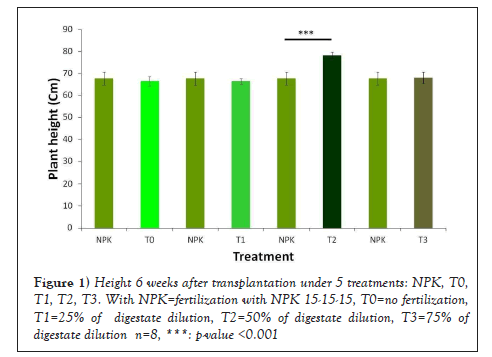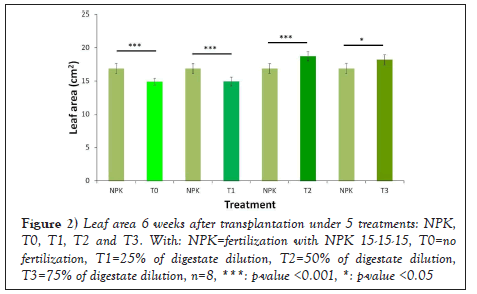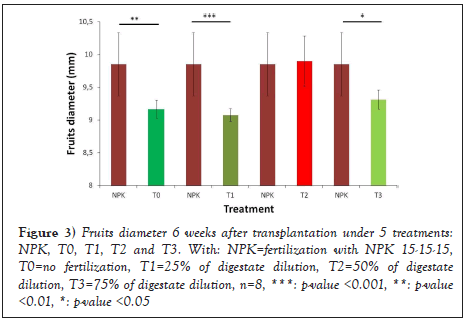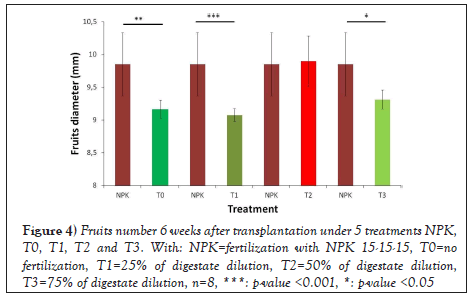Agricultural and Biological Research
RNI # 24/103/2012-R1
Research Article - (2022) Volume 38, Issue 3
Tomatoes are known for their human health benefits. Tomato producers use chemical fertilizers to increase tomato production levels. However, the use of organic fertilizers such as digestate can achieve satisfactory yields while sustaining the soil environment. In this tomato study, the effect of three dilutions of digestate (25%, 50% and 75%) on plant height, leaf area and fruit number were compared to NPK 15 15 15. The 50% dilution of digestate had the most beneficial effect on the plants at the end of the experiment.
Tomato; Health; Chemical fertilizers; Digestate
Tomato (Lycopersicon esculentum Mill) is one of the most popular and nutritious vegetables in the world [1]. The nutritional and chemical composition of the tomato makes it a unique plant, it contains the following natural components vitamin C, vitamin A (as carotenoids), fiber, potassium, and the antioxidant lycopene thus the consumption of tomatoes and tomato products has a beneficial effect on human health [2]. According to the FAO, the annual world production of tomatoes is estimated at about 123 million tons with a total production area of about 4.5 million ha [3]. While in Central Africa production was 1286716 tons with a total production area of 116804 ha in 2019 [4]. Vegetables need adequate growing conditions to have an optimal yield, among these conditions tomato requires adequate fertilizer for growth and yield [5]. For several decades chemical fertilizers were the only ones used to increase plant yields [6], due to the negative impact of chemical fertilizers on the environment, their use should be minimized in the context of sustainable agriculture [7]. Indeed, climate change took farmers to review their production systems, that improvement is relied on government programs based on the Millennium Development Goals and also on Sustainable Development Goals [8]. For the threat of climate change, sustainable agricultural practice has an important role to play in food insecurity [9] despite that agricultural sector in Africa is faced with insufficient access to efficient inputs [10]. Utilization of organic fertilizer by Africans farmers could participate to sustainable agricultural, the use of organic fertilizers provides nutrients for the plant and also increase microbial activity in soil [11,12]. Furthermore, soil organic matter is rich in natural resources, such as nitrogen, phosphorus, and potassium (N, P, and K) in organic forms but these elements persist longer in the soil compared to their mineral [12]. Thus, [13] have shown that an optimized use of organic fertilizers contributes to sustainable agriculture. We used the organic fertilizer called digestate which is a by-product of methane and heat production in a biogas plant, coming from organic wastes; it could be solid or liquid depending on the biogas technology [14]. In this study, the objective is to evaluate the effect of 3 dilutions (25%, 50% and 75%) of digestate on height, leaf area and fruits number of tomato in comparison with a chemical fertilizer of NPK 15 15 15 in the presence of no fertilizing control.
The study was conducted at the “Institut de Recherches Agronomiques et Forestières” (0° 25' 16, 571" N and 9°25' 55, 518" E).
Plant material
In this study we used tomato seeds of the hybrid variety MONGAL F1 (INRAE), it is high-yield variety [15].
Soil composition
The soil used was analyzed to determine its composition. Its composition is presented in Table 1 below.
| Composition | Quantity |
|---|---|
| Water content | 8.33% |
| Total organic matter | 1.94% |
| Total organic Carbon | 11.2% |
| Total Nitrogen | 0.28% |
| Phosphorus (P2O5) | 0.11% |
| Potassium (K2O) | 0.61% |
| Calcium (CaO) | 1.67% |
| Magnesium (MgO) | 0.39% |
| Sodium (Na2O) | 1.28% |
| Aluminium (Al2O3) | 5.15% |
| Iron (Fe2O3) | 4.38% |
| Manganese oxide (MnO) | 0.02% |
| Silica (SiO2) | 61.8 ppm |
| Copper (Cu) | 22 ppm |
| Molybdenum (Mo) | 0.5 ppm |
| Zinc (Zn) | 56 ppm |
| Chloride (Cl-) | 4 g/T |
| Conductimetry/T°C | 107.3/25 µS/cm |
| pH | 6.98 |
| Ratio C/N | 40 |
Table 1: The soil used was analyzed to determine its composition.
Digestate composition
Analyzes carried out on the digestate in liquid form used for this study has allowed to identify elements it contains (Table 2). Three dilutions of pure digestate (Table 2) were tested in our study, first dilution at 25%, second at 50% and third at 75%.
| Composition | Quantity |
|---|---|
| Total organic matter | 35.64% |
| Total organic Carbon | 206.7% |
| Total Nitrogen | 7.8% |
| Phosphorus (P2O5) | 7.46% |
| Potassium (K2O) | 7.74% |
| Calcium (CaO) | 2.38% |
| Magnesium (MgO) | 0.86% |
| Sodium (Na2O) | 9.62% |
| Aluminium (Al2O3) | 0.47% |
| Iron (Fe2O3) | 4.38% |
| pH | 7.51 |
| Ratio C/N | 26.5 |
Table 2: The digestate used was analyzed to determine its composition.
Experimental procedures
The substrate used in this study is a mixture of soil (Table 1) and sand (2V: V), sand’s grain size was between 62.5 μm and 125 μm. The substrate has been disinfected at 120°C during 20 minutes. Tomato’s seeds were sown in trays for nursery use and young plant were transplanted into plastic bags 4 weeks later and monitored for 6 weeks. Experiment was laid out in a randomized Complete Block Design (RCBD) with 8 replications and five treatments. Treatments used were a control without fertilizer (T0), NPK 15 15 15 (NPK), and three dilutions of digestate in the liquid form 25% (T1), 50% (T2) and 75% (T3).
Measurements of plants heights, leaves sizes and fruits diameters
Plants heights and leaves sizes were measured with a measuring tape; fruits diameters were measured with a Caliper.
Statistical analysis
Analysis were performed using Excel [16], for each parameter, the analyses compared the plants from treatment NPK with the plants from each of the treatment T0, T1, T2 and T3.
In order to follow the digestate effect on plant growth, plants height, leaf area and fruits number were measured once a week in all the treatments. However, only the measurements made at the end of the experiment are presented.
Plant height
Plant height measurements were taken for each treatment from the first to the seventh week after transplanting. Dimension was taken from the collar to the last leaf. Among the treatments, strong significant differences (p-value<0.001) of plant height were observed between the T2 treatment (50% of digestate) and the NPK treatment (Figure 1) at the end of the trial (6 weeks after transplanting). Plants from treatment T2 having significantly larger heights than those from treatment NPK. Average value of plants height from treatments T2 and NPK are respectively 78.21 cm and 67.64 cm.
Leaf area

Figure 1: Height 6 weeks after transplantation under 5 treatments: NPK, T0, T1, T2, T3. With NPK=fertilization with NPK 15-15-15, T0=no fertilization, T1=25% of digestate dilution, T2=50% of digestate dilution, T3=75% of digestate dilution n=8, ***: p-value <0.001.
Leaf Area (LA) measurements were taken on the same leaves for each treatment [17] the first to the seventh week after transplanting. Leaf length was measured as the distance between the insertion of the first leaflet on the rachis to the distal end whereas leaf width was measured on the widest leaflet [16]. Among the treatments, strong significant differences (p-value<0.001) of LA were observed between T0 (no fertilizing) and NPK, T1 (25% of digestate) and NPK, also T2 (50% of digestate) and NPK, while significant differences (p-value<0.05) of LA were observed between T3 (75% of digestate) and NPK at the end of the trial (Figure 2). Only plants from treatment T2 had a larger LA than those from NPK. Average value of plants LA from treatments T2 and NPK are respectively 18.73 cm² and 16.86 cm² at the end of the trial.

Figure 2: Leaf area 6 weeks after transplantation under 5 treatments: NPK, T0, T1, T2 and T3. With: NPK=fertilization with NPK 15-15-15, T0=no fertilization, T1=25% of digestate dilution, T2=50% of digestate dilution, T3=75% of digestate dilution, n=8, ***: p-value <0.001, *: p-value <0.05.
Fruit diameter
Fruit diameter measurements were taken on all fruits for each treatment at the end of the trial. Among the treatments, strong significant differences (p-value<0.01) of fruit diameter were observed betweenT0 and NPK, T1 and NPK, and also significant differences (p-value<0.05) between T3 and NPK. Despite these differences, the plants from the NPK treatment having the largest diameters. However no difference of fruit diameter was observed between T2 and NPK at the end of the trial (Figures 3 and 4).

Figure 3: Fruits diameter 6 weeks after transplantation under 5 treatments: NPK, T0, T1, T2 and T3. With: NPK=fertilization with NPK 15-15-15, T0=no fertilization, T1=25% of digestate dilution, T2=50% of digestate dilution, T3=75% of digestate dilution, n=8, ***: p-value <0.001, **: p-value <0.01, *: p-value <0.05.

Figure 4: Fruits number 6 weeks after transplantation under 5 treatments NPK, T0, T1, T2 and T3. With: NPK=fertilization with NPK 15-15-15, T0=no fertilization, T1=25% of digestate dilution, T2=50% of digestate dilution, T3=75% of digestate dilution, n=8, ***: p-value <0.001, *: p-value <0.05.
Fruit number
Fruit Number (FN) was counted for each treatment at the end of the trial. Among the treatments, strong significant differences (p-value<0.001) of fruit diameter were observed between T0 and NPK, T2 and NPK, T3 and NPK and also significant differences (p-value<0.05) between T1 and NPK. Only plants from treatment T2 had a larger FN than those from NPK. Average value of plants FN from treatments T2 and NPK are respectively 4.25 and 2.5 at the end of the trial [18,19].
There is often variability between soils in different regions and even within a field. In view of the high population growth in Africa, the use of optimal soil management methods would help to increase the yields of agricultural production. Utilization of organic fertilizer by Africans farmers could participate to sustainable agricultural; the use of organic fertilizers provides nutrients for the plant and also increases microbial activity in soil.
In this study, it was observed that the plants from the T2 (50% of digestate) treatment had the best vegetative development and the highest yield at the end of the trial compared to NPK (NPK 15 15 15), T0 (25% of digestate) and T3 (75% of digestate). This result is in agreement with the work of who obtained better vegetative development and yield with green manure used as organic fertilizer compared to the NPK 15 15 15 treatment. Digestate could therefore be used as a substitute for chemical fertilizers insofar as plants grown in soil fertilized with digestate have significantly higher yields than plants grown in soil fertilized with NPK. Furthermore, its use preserves the soil biomass, unlike chemical fertilizers.
However an optimal concentration of the digestate would result in good quality plants and high yields. In our trial, T2 would be the optimal treatment in view of the results obtained with plants from treatments T0 (no fertilizing), T1 (25% of digestate) and T3 (75% of digestate).
Our study showed that the application of digestate (organic fertilizer) as a fertilizer at an optimal dose during tomato cultivation results in higher yields than those obtained with NPK 15 15 15. The digestate could therefore replace NPK (chemical fertilizer) which has a negative impact on the environment.
Our acknowledgement goes to the General Direction of Livestock for the provision of digestate and the colleagues of IRAF who contributed to the realization of this work.
Citation: Effa Effa BW, Demikoyo DS, Mibemu Guibinga S, et al. Effects of organic fertilizer digestate on the growth of tomato ( Lycopersicon esculentum Mill ). AGBIR. 2022; 38(3):288-290.
Received: 18-May-2022, Manuscript No. AGBIR-22-64135; , Pre QC No. AGBIR-22-64135 (PQ); Editor assigned: 23-May-2022, Pre QC No. AGBIR-22-64135 (PQ); Reviewed: 06-Jun-2022, QC No. AGBIR-22-64135; Revised: 13-Jun-2022, Manuscript No. AGBIR-22-64135 (R); Published: 20-Jun-2022, DOI: 10.35248/0970-1907.22.38.288-290
Copyright: This open-access article is distributed under the terms of the Creative Commons Attribution Non-Commercial License (CC BY-NC) (http:// creativecommons.org/licenses/by-nc/4.0/), which permits reuse, distribution and reproduction of the article, provided that the original work is properly cited and the reuse is restricted to noncommercial purposes. For commercial reuse, contact reprints@pulsus.com This is an open access article distributed under the terms of the Creative Commons Attribution License, which permits unrestricted use, distribution, and reproduction in any medium, provided the original work is properly cited.
